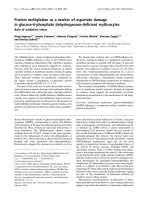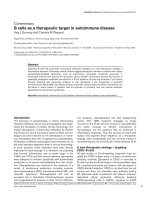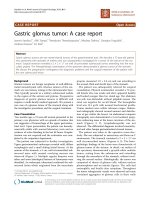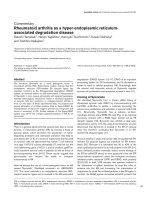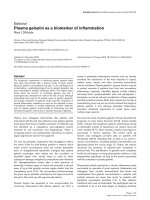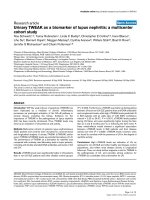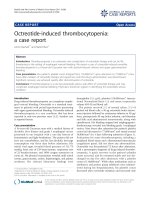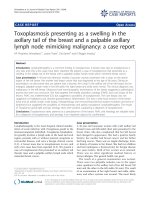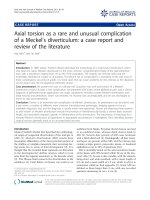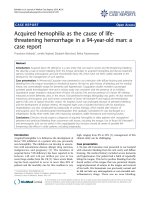Báo cáo y học: "Serous labyrinthitis as a manifestation of cat scratch disease: a case report" ppt
Bạn đang xem bản rút gọn của tài liệu. Xem và tải ngay bản đầy đủ của tài liệu tại đây (390.85 KB, 4 trang )
Case report
Open Access
Serous labyrinthitis as a manifestation of cat scratch disease:
a case report
Ilias Kantas
1
*, Michael Katotomichelakis
2
, Marinos Vafiadis
1
,
Zografia V Kaloutsa
1
and Chariton E Papadakis
3
Addresses:
1
Department of Otolaryngology, ‘G. Genimmatas’ General Hospital, Karditsa, Thessaloniki, Greece
2
Department of Otolaryngology, ‘Agia Olga’ General Hospital, Athens, Greece
3
Department of Otolaryngology, Chania General Hospital, Chania, Crete, Greece
Email: IK* - ; MK - ; MV - ; ZVK - ; CEP -
* Corresponding author
Received: 25 June 2008 Accepted: 10 June 2009 Published: 15 September 2009
Journal of Medical Case Reports 2009, 3:7405 doi: 10.4076/1752-1947-3-7405
This article is available from: />© 2009 Kantas et al.; licensee Cases Network Ltd.
This is an Open Access article distributed under the terms of the Creative Commons Attribution License (
/>which permits unrestricted use, distribution, and reproduction in any medium, provided the original work is properly cited.
Abstract
Introduction: Cat scratch disease is an infectious disease transmitted by young cats, in which the
principal causative factor is Bartonella henselae. The typical course of cat scratch disease is usually
benign and self-limited and requires only supportive therapy. However, cases lasting up to 2 years
have been reported, and more serious complications may occur. Many manifestations of the disease
have been reported by different medical disciplines.
Case presentation: A case of cat scratch disease in a 71-year-old Greek woman with an unusual
clinical course is presented here. Serous otitis media was combined with rotational vertigo due to
labyrinthitis. The invaded ear was ipsilateral to the inoculation site.
Conclus ion: C ervicofacial lymphadenopathy has been demonstrate d as the most commo n
otolaryngologic manifestation of cat scratch disease. Manifestation in the middle and inner ear has,
to the best of our knowledge, not been reported before. Our report presents a patient with cat
scratch disease with clinical signs and symptoms in the middle and inner ear.
Introduction
Selby and Walker advocated an avasculitic origin of cat
scratch disease (CSD) after demonstrating cerebral arteritis
in a 7-year-old girl suffering from CSD [1]. In 1992,
Regnery et al. reported Bartonella henselae to be the major
causative agent of CSD [2]. Therefore, CSD is considered as
a zoonosis with many clinical manifestations as well as a
cosmopolitan emerging human pathogen [3]. Typical CSD
can occur in all ages. Usually, 3 to 10 days after contact
with an infected cat, most often a newly acquired kitten,
a non-tender 1 mm to 10 mm red to brown papule
develops, followed by prolonged regional lymphadeno-
pathy for another 14 days.
Most authors have described typical CSD as a self-limited
disease with a subsidence of symptoms within 2 to 4
months. However, cases lasting up to 2 years have been
reported, and more serious complications may occur.
Page 1 of 4
(page number not for citation purposes)
Different organs can be affected, including the eyes, liver,
spleen, central nervous system, skin and bones, among
others [3,4]. Many otolaryngologic manifestations of the
disease have been observed. However, manifestations in
the middle or inner ear have, to the best of our knowledge,
not been reported so far. Our report presents a patient with
CSD with clinical signs and symptoms in the middle and
inner ear.
Case presentation
A 71-year-old Greek woman complaining of rotational
vertigo was admitted to the ENT (ear, nose and throat)
department at the “G. Genimmatas” General Hospital of
Thessaloniki, for investigation and treatment. The patient
had an unexplained fever, with an axillary body tempera-
ture of over 39°C, taken in several measurements during
the 15 days before admission.
During ENT clinical examination and Romberg’s test, the
patient tended to fall towards the right. Observation using
Frenzel glasses showed spontaneous nystagmus with the
fast component toward the left.
Otomicroscopic examination revealed serous otitis media
on the left ear. ENT endoscopic examination for rhino-
pharyngeal, oropharyngeal or hypopharyngeal lesions was
negative. Neurologic examination was normal. A block of
the axillary lymph nodes, not fluctuant or accompanied by
overlying erythema, was presented on the left side. A skin
lesion resembling a round, red to brown, non-tender
papule was observed on the left subclavicular area during
clinical examination (Figure 1). The patient did not report
any previous history of influen za or virus infection.
However, she mentioned having daily contact with two
kittens. This history, along with the skin lesion on the left
subclavicular area, raised the suspicion for CSD, although
the patient did not remember any cat scratching or biting.
Rinne’s test was negative on the left and positive on the
right ear, respectively. The patient localized the tone on the
left side during Weber’s test. Tympanometry appeared as
a flat curve on the left side (a type B tympanogram) due
to serous exudate in the middle ear. The right-ear tympa-
nogram showed a normal type A curve. A pure-tone
audiogram showed a conductive hearing loss on the left
side with a gap of 10 dB to 15 dB. On electronystagmo-
graphy testing, the main abnormal finding was the
presence of an intense spontaneous nystagmus of a
peripheral type, both with and without an optic fixation.
The direction of the fast phase of the nystagmus toward the
site of the lesion along with the presence of a directional
preponderance (83%) towards the side of the lesion
showed an impaired horizontal semicircular canal of the
left labyrinth.
Differential diagnosis for specific lymphadenopathy
includes tuberculosis, sarcoidosis, syphilis, diphtheria,
tularemia, toxoplasmosis and CSD. The specific history
and the skin lesion pointed towards CSD. The chest
radiogram was normal. Erythrocyte sedimentation rate
was 78 mm per hour, and C-reactive protein was 56 mg/
dL. Immunoglobin (Ig) M and IgG serologic control was
negative for toxoplasmosis, cytomegalovirus, Epstein-Barr
virus and HIV.
Serologic control for Bartonella henselae was sent to
National Institute of Pasteur in Athens. Azithromycin
was administered for 6 days in combination with
methylprednisolone and dimenhydrinate during the wait
for the test results, which confirmed the diagnosis of CSD.
Paracentesis of the tympanic membrane was performed,
and 2 cc of fluid materials from the mesotympanum were
taken and sent for culture tests. After wide tympanostomy,
mucosal pieces were taken from the promontory area
using micro ear forceps with oval cupped jaws and sent for
polymerase chain reaction (PCR) control. Culture results
were negative for Bartonella henselae. Total DNA was
isolated from promontory mucosal cells, according to
the standard procedures (QIAGEN-Tissue DNA isolation
kit, QIAGEN GmbH, G ermany) and was used as a
template in a real-time PCR (ROCHE LightCycler 1.1),
with primers and probes (FRET technology) specially
designed to multiply and detect the OspA region of
Bartonella species (B. bacilliformis, B. elizabethae, B. vinsonii,
B. quintana and B. henselae). The results obtained by the
PCR analysis revealed the presence of Bartonella henselae
DNA in the clinical specimen. The first serologic results for
Bartonella henselae strengthened our suspicion for CSD
(IgM: 20, IgG: 270). IgG blood antibodies increased
impressively 3 weeks later (IgG: 1100). This four-fold rise
Figure 1. A skin lesion resembling a round, red to brown,
non-tender papule on the left subclavicular area.
Page 2 of 4
(page number not for citation purposes)
Journal of Medical Case Reports 2009, 3:7405 />of IgG blood antibodies finally confirmed the diagnosis
of CSD. The patient was discharged from the hospital
symptom-free one week after admission.
Discussion
Epidemiologic studies revealed that owners of kittens
younger than 12 months were 15 times more likely to
develop CSD than owners of adult cats [5]. Typical CSD
can occur in immunocompromised or immunocompetent
patients of all ages alike. The history is always associated
with cat scratches, bites or exposure to cat saliva. The
disease initially develops as a small skin lesion at the site
of the scratch or bite, followed by a round red to brown,
non-tender papule after 3 to 10 days [6].
Bartonella henselae is a proteobacteria that can cause
bacteremia, endocarditis, bacillary angiomatosis, peliosis
hepatis and CSD. The diagnos is of CSD is us ually
confirmed by the presence of IgM antibodies against
B. henselae after serologic control and in combination with
IgG antibodies at the first examination, which then shows
a rising titer in a second serologic follow-up after 10 to 14
days [7]. When it is not possible to isolate the causative
agent within the labyrinthine fluids, identification of the
agent within the tissue of the middle ear is almost as
reliable [8]. The histologic findings of invaded lymph
nodes are inflammatory granulomas with micro-abscesses
surrounded by histocytes, lymphocytes, occasional giant
cells and fibrosis. In other words, they are very similar to
the findings in other granulomatous diseases such as
tularemia, lymphogranuloma venereum and brucellosis
and have to be distinguished from these by molecular
methods [7].
CSD may present in a typical or atypical fashion in both
immunocompetent and immunocompromised patients.
The spectrum of CSD includes lymphadenopathy, usually
regional and unilateral, which occurs 1-3 weeks after the
infecting cat scratch, with gradual nodal enlargement.
Sometimes, patients appear to be quite well generally,
with only mild, non-specific symptoms such as headache,
anorexia, myalgia or abdominal pain [9].
The most typical manifestation of CSD is Parinaud’s
oculoglandular syndrome, consisting of unilateral pre-
auricular lymphadenopathy and conjunctivitis [9]. Un-
explained fever, Keber’s stellate neuroretinitis [9],
endocarditis [10], encephalopathy [11], acute hemiplegia
[6], facial palsy and partial ptosis [12] have all been
reported as manifestations of CSD. Ridder et al.[7]
described the most usual ENT manifestations of CSD in
a number of the 99 patients they examined, after serologic
confirmation in a retrospective analysis. These authors
reported lymphadenopathy in 100% of cases as the first
manifestation (acute, abscessed and chronic), followed by
a swelling of the parotid lymph nodes (34.3%), phary-
ngitis (15.2%), fever (9.1%), Parinaud’s syndrome
(8.1%) and swelling of parotid gland (6.1%). As rare
manifestations, they reported tonsillitis, laryngitis, and
perichondritis of the auricle [7]. The same first author
reported a case of CSD mimicking a hypopharyngeal
tumor [13].
Azithromycin has been advocated as modestly hastening
the resolution of lymphadenopathy [14]. Macrolides,
rifampin, doxycycline, gentamicin, trimethoprim-sulfa-
methoxazole and ciproxin alone or in combination have
also been suggested as agents for treatment.
The pathogenesis of CSD complications in the central
nervous system still remains obscure. To the best of our
knowledge, manifestation in the inner and middle ear
have not been reported so far. The pathogenesis of serous
labyrinthitis in our patient may be due to toxins present in
the labyrinth, rather than due to the presence of bacteria in
the inner ear.
Conclusion
The manifestation of CSD in the middle and inner ear is
rare.
Consent
Written informed consent was obtained from the patient
of this case report for publication and any accompanying
images. A copy of the written consent is available for
review by the Editor-in-Chief of this journal.
Competing interests
The authors declare that they have no competing interests.
Authors’ contributions
IK conceived the study, and was involved in drafting the
manuscript. MK participated in the study design, and was
involved in drafting the manuscript. MV and ZVK collected
the data, formatted the images, participated in the study
design and were involved in drafting the manuscript. CEP
participated in the study design and coordination,
performed language corrections and critically evaluated
the article. All authors read and approved the final
manuscript.
References
1. Selby G, Walker GL: Cerebral arteritis in cat-scratch disease.
Neurology 1979, 29:1413-1418.
2. Regnery RL, Olson JG, Perkins BA, Bibb W: Serological response
to “Rochalimaea henselae” antigen in suspected cat-scratch
disease. Lancet 1992, 339:1443-1445.
3. Anderson BE, Neuman MA: Bartonella spp as emerging human
pathogens. Clin Microbiol Rev 1997, 10:203-219.
4. Bass JW, Vincet JM, Person DA: The expanding spectrum of
Bartonella infections: II. Pediatr Infect Dis J 1997, 16:163-179.
5. Zangwill KM, Hamilton DH, Perkins BA, Regnery RL, Plikaytis BD,
Hadler JL, Cartter ML, Wenger JD: Cat scratch disease in
Page 3 of 4
(page number not for citation purposes)
Journal of Medical Case Reports 2009, 3:7405 />Connecticut. Epidemiology risk factors and evaluation of a
new diagnostic test. N Engl J Med 1993, 329:8-13.
6. Rocha JL, Pellegrino LN, Riella LV, Martins LT: Acute hemiplegia
associated with cat-scratch disease. Brazil J Infect Dis 2004, 8:263-
266.
7. Ridder GJ, Boedeker CC, Technau-Ihling K, Sander A: Cat-scratch
disease: otolaryngologic manifestations and management.
Otolaryngol Head Neck Surg 2005, 132:353-358.
8. Davis LE, Johnsson LG: Viral infections of the inner ear: clinical,
virologic, and pathologic studies in humans and animals. Am J
Otolaryngol 1983, 4:347-362.
9. Batts S, Demers DM: Spectrum and treatment of cat scratch
disease. Pediatr Infect Dis J 2004, 23:1161-1162.
10. Baorto E, Payne RM, Slater LN, Lopez F, Relman DA, Min KW,
St Geme 3rd: Culture-negative endocarditis caused by Barto-
nella Henselae. J Pediatr 1998, 132:1051-1054.
11. Noah DL, Bresee JS, Gorensek MJ, Rooney JA, Cresanta JL,
Regnery RL, Wong J, del Toro J, Olson JG, Childs JE: Cluster of
five children with acute encephalopathy associated with cat-
scratch disease in south Florida. Pediatr Infect Dis J 1995, 14:866-
869.
12. Ganesan K, Mizen K: Cat-scratch disease an unusual cause of
facial palsy and partial ptosis: case report. J Oral Maxillofac Surg
2005, 63:869-872.
13. Ridder GJ, Richter B, Laszing R: A farmer with a lump in his
throat. Lancet 1998, 351:954.
14. Bass JW, Freitas BC, Freitas AD, Sisler CL, Chan DS, Vincent JM,
Person DA, Claybaugh JR, Wittler RR, Weisse ME, Regnery RL,
Slater LN: Prospective randomized prospective randomized
double blind placebo-controlled evaluation of azithromycin
for treatment of cat-scratch disease. Pediatr Infect Dis J 1998,
17:447-452.
Do you have a case to share?
Submit your case report today
• Rapid peer review
• Fast publication
• PubMed indexing
• Inclusion in Cases Database
Any patient, any case, can teach us
something
www.casesnetwork.com
Page 4 of 4
(page number not for citation purposes)
Journal of Medical Case Reports 2009, 3:7405 />
